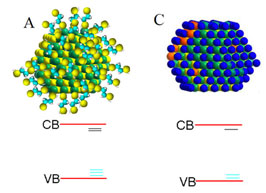
QDs Improve Next-Gen Solar Cells by 6%
A promising technique for improving solar conversion efficiency has been developed using tightly packed quantum dots assembled on the surface of solar cells.
Researchers from the University of Toronto (U of T), the King Abdullah University of Science & Technology (KAUST) and Pennsylvania State University (Penn State) said this new technique, based on collodial quantum dots (CQD), has created solar cells with power conversion efficiency up to 6 percent — the most efficient solar cell ever made.
QD solar cells are typically known for being less expensive to produce and more durable than the more widely known silicon-based solar cells, but the team said the challenge has been striking a balance between convenience and performance. To enhance performance, they needed to figure out how to pack the QDs more tightly together because the greater the distance between the QDs, the lower the efficiency.
QDs are usually capped with organic molecules that add only a nanometer or two, but when working on a nanoscale, that’s pretty bulky. The organic molecules, however, have been an important ingredient in creating a colloid, which is a substance that is dispersed in another substance. This allows the quantum dots to be painted onto other surfaces.

Left: Quantum dots capped with organic ligands. Bulky organic molecules (yellow and blue) have led to lower performance. Right: Quantum dots capped with the novel inorganic ligands reported in the work. Reduced bulk helped get electrons out, leading to record performance. (Image: Ted Sargent)
To solve the problem, the researchers have turned to inorganic ligands, which bind the quantum dots together while using less space. The result is the same colloid characteristics, butwithout the bulky organic molecules.
“We wrapped a single layer of atoms around each particle. As a result, they packed the quantum dots into a very dense solid,” said U of T’s Dr. Jiang Tang, first author of the study.
“It is very impressive that the team was able to make solar cells with power conversion efficiency up to 6 percent from quantum dots,” said Michael McGehee, a professor at Stanford University and a world-renowned expert in solution-processed organic solar cells. “There is a lot of surface area in these films that could have dangling bonds which would hinder the performance of solar cells by creating trap states.”
The team showed the highest electrical currents and the highest overall power conversion efficiency ever seen in CQD solar cells. The performance results were certified by the Newport Technology & Applications Center’s Photovoltaic Lab, an external laboratory that is accredited by the US National Renewable Energy Laboratory.
“The team proved that we were able to remove charge traps — locations where electrons get stuck — while still packing the quantum dots closely together,” said co-author John Asbury, a professor at Penn State.
The combination of close packing and charge trap elimination enabled electrons to move rapidly and smoothly through the solar cells, thus providing record efficiency.
“This finding proves the power of inorganic ligands in building practical devices,” said University of Chicago professor Dmitri Talapin, who is considered a research leader in the field. “This new surface chemistry provides the path toward both efficient and stable quantum dot solar cells. It It should also impact other electronic and optoelectronic devices that utilize colloidal nanocrystals. Advantages of the all-inorganic approach include vastly improved electronic transport and a path to long-term stability.”
“We proved that the inorganic passivants were tightly correlated with the location of the quantum dots, and that it was this new approach to chemical passivation, rather than nanocrystal ordering, that led to this record-breaking colloidal quantum dot solar cell performance,” said Aram Amassian of DAUST, a co-author of the work.
As a result of the potential of this research discovery, a technology licensing agreement, brokered by MaRS Innovations, has been signed by U of T and KAUST, enabling the global commercialization of this new technology.
The discovery is reported in the latest issue of Nature Materials.
For more information, visit: www.ecf.utoronto.ca
Published: September 2011